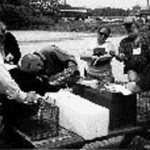Research
Evaluation of the Humaneness of Rodent Capture Using Glue Traps, Prepared for the Canadian Association of Humane Trapping, 31 July 2013 Author: Nicole Fenwick, M.Sc.
Evaluation of the Humaneness of Rodent Capture Using Glue Traps Prepared for the Canadian Association of Humane Trapping, 31 July […]
Reducing accidental shrew mortality associated with small-mammal livetrapping II: a field experiment with bait supplementation by Randy Do, Julia Shonfield, and Andrew G. McAdam
The CAHT funding of the valuable research was made possible through your donations. The paper is published in Volume 94, […]
Reducing accidental shrew mortality associated with small-mammal livetrapping I: an inter- and intrastudy analysis by Julia Shonfield, Randy Do, Ronald J. Brooks, and Andrew G. McAdam
The CAHT funding of the valuable research was made possible through your donations. The paper is published in Volume 94, […]

Evaluating Relocation as a Means to Deal with Nuisance Wildlife
It is necessary to understand and to think critically about all aspects of live-trapping. The live-capture of an animal may solve one problem, but it introduces another. That is, what will be done with the captured animal?

Trap Standards Development – Historical Perspectives by Neal Jotham, Chairman ISO TC191 (1987-present)
The early initiative toward drafting Canadian National Humane Trap Standards was made possible because of the pioneering project established jointly by the Canadian Federation of Humane Societies (CFHS) and the Canadian Association for Humane Trapping (CAHT) in 1968. These organizations began the first multi-disciplined, scientific approach to research and development for improving the humaneness of trapping systems.

Monitoring stress in wildlife: how to do it and why does it matter? (Summer 2009) By Ben Dantzer
A common attribute among all animals (including humans) is the stereotypical physiological response to a stressor. Whether it is from your workplace, family, or even the continual abysmal performance from your favourite hockey team (Leafs), we all experience some sort of stress in our daily lives.

Humane Live-Trapping of Red Squirrels (Summer 2009) By: Zahirul Islam, Curtis Bosson and Rudy Boonstra
International and Canadian federal laws require that animals suffer minimal pain and suffering when they are trapped. In the fur industry this has lead to the development away from foot-hold traps toward instant kill traps such as snap traps or conibear traps.
